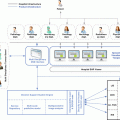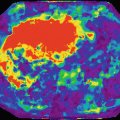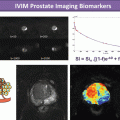Genomic test
Target
Specimen requirements
Technique
Characteristics
OncotypeDx
21 genes
FFPE
RT-PCR
Recurrence score (0–100) predicts likelihood of recurrence at 10 years. Role in predicting response to adjuvant and neoadjuvant chemotherapy validated
MammaPrint
70 genes
Unfixed tissue
Microarray
10 years survival probability divided into low and high risk
PAM50 ROR
50 genes
FFPE
RT-PCR, nCounter technology
Links intrinsic breast cancer subtype and 5 years risk of recurrence in ERpositive disease
76-Gene signature
76 genes
Unfixed tissue
Microarray
Predicts outcomes for LN-negative patients independent of hormone receptor status
H:I ratio/breast cancer index
HOXB13 to IL17BR ratio and molecular gene index
FFPE
RT-PCR
Particularly useful in predicting late recurrence (5–10 years from diagnosis)
IHC4
Levels (%) of ER, PR HER2, and Ki67
FFPE
IHC
Modeling factors in ER, PR, HER2, and Ki67 ICH. Predictor for distant recurrence
Genomic grade index
97 genes
Unfixed tissue
Microarray
Classifies histologic grades into low and high recurrence risk. High GGI is associated with increased risk of recurrence compared to low GGI
17.3 Quantitative Breast Imaging Biomarkers
17.3.1 Risk Prediction for the Development of Breast Cancer
17.3.1.1 Breast Density on Mammography
By expert consensus, mammographic breast density is one of the strongest known risk factors for the disease and is comparable to or exceeds values identified through many other known factors, such as alcohol or obesity [25–33] (Table 17.2).
Table 17.2
List of risk factors for breast cancer and relative risk
Factors that increase the relative risk for breast cancer | ||
|---|---|---|
Relative risk | Factors | |
Gender | Female | |
Age | >65 | |
Race | Caucasian | |
>4.0 | Certain genome changes | BRCA1/BRCA 2 |
Family history | Two or more fist-degree relatives with breast cancer diagnosed at an early age | |
Personal health history | Prior diagnosis of breast cancer or high risk lesions | |
Breast density | High percentage of dense tissue | |
Family history | One first-degree relative with breast cancer | |
2.1–4.0 | Personal health history | High-dose bone radiation to chest |
High bone density (postmenopausal) | ||
Early menarche (<12) | ||
Late age at first full-term pregnancy (>30) | ||
Late menopause (>55) | ||
No full-term pregnancy | ||
Factors that affect circulating hormones | Never breastfed a child | |
Recent oral contraceptive use | ||
1.1–2.0 | Recent and long-term use of hormone replacement therapy | |
Personal history of endometrium, ovary, or colon cancer | ||
Obesity (postmenopausal) | ||
Lack of physical activity | ||
Poor diet | ||
Other factors | Being overweighted or obese | |
Alcohol consumption | ||
Mammographic breast density is defined as the proportion of the breast area in the mammogram that is occupied by radiologic dense breast tissue. It refers to the variations in the radiological appearance of the breast among women, which reflect variations in breast tissue composition [25, 27, 28]. Mammographic density mainly consists of two components of tissues: fibroglandular and fatty tissue. Fibroglandular tissue is a mixture of fibrous connective tissue, specifically the stroma and the functional or glandular epithelial cells that line the ducts of the breast (the parenchyma). Fat has a lower X-ray attenuation coefficient than fibroglandular tissue and, thus, is more transparent on X-rays and appears darker on a mammogram. Regions of brightness that are associated with fibroglandular tissue are referred to as “mammographic densities.”
The relationship between the different mammographic density phenotypes (absolute dense area, absolute nondense area, and percentage dense area) and breast cancer risk seems to indicate that percentage dense area has been estimated to be a stronger risk factor than absolute dense area for breast cancer [28]. Women with a high percentage of dense area of >75 % had a 4.6-fold increased breast cancer risk (95 % confidence interval, 3.6–5.9) compared with women with little (<5 %) dense tissue [27–30, 34]. The level of risk is largely unknown because tissue density is influenced by multiple factors, both genetic and environmental. For example, breast density decreases with an increasing body mass index and decreases with aging and multiparity [26, 32, 33]. Other factors also affect a woman’s tissue density, such as tamoxifen therapy, hormone replacement therapy, weight, and diet intake changes [35]. Nevertheless, regardless of the influence of other risk factors, breast density is now an established independent risk factor for the development of breast cancer [25, 26, 36] (Table 17.3).
Table 17.3
For percentage density measured using prediagnostic mammograms, there are combined relative risks of incident breast cancer in the general population
Risk of developing breast cancer associated to breast density | ||||
|---|---|---|---|---|
BI-RADS ACR a | BI-RADS ACR b | Bl-RADS ACR c | BI-RADS ACR d | |
% Breast density measured on mammography | 5–24 % | 25–49 % | 50–74 % | >75 % |
Combined relative risks | 179(148–2.16) | 2.11 (1.70–2.63) | 2.92 (2.49–3 42) | 4.64 (3.64–5.91) |
Breast dense tissue is common in women, with 31–43 % of the general screening population having heterogeneously dense or extremely dense breasts at mammography [27]. Therefore, breast density assessment has been an important component of screening mammography reports and has been propelled to the forefront by recent legislation in several states that requires patients to be informed of breast density and the potential for the increased cancer risk [31]. Breast density affects mammographic screening also because of the masking effect on underlying cancers. It is well known that mammographic sensitivity decreases with increasing density, from a level of 85.7–88.8 % in patients with almost entirely fatty tissue to 62.2–68.1 % in patients with extremely dense breast tissue [37, 38]. The masking effect of breast density leads to an increased percentage of interval cancers (cancers that manifest within 1 year of a normal mammogram) in women with dense breasts. It has been suggested that, because dense breasts may make a woman more likely to be diagnosed with an interval cancer, women with dense breasts might benefit from intensified screening [27, 39]. Therefore, the ability to identify women at greater risk from breast cancer could be used as a prognostic indicator and as a selection criterion for high-risk groups, who would benefit from special surveillance measures [29, 30, 40–42]. Hence, breast density might have great potential as a biomarker, to be used as an intermediate end point in studies of breast cancer etiology and as a component of overall risk-assessment models. To date, breast density assessment, both qualitative and quantitative, is based on mammography. Mammography is a 2D technique, which examines the breast, a 3D structure, employing both ionizing radiation and compression [40, 41, 43]. Calculation of breast density based on mammography can be done either qualitatively, by subjective visual radiologist review, or quantitatively, by either semiautomated 2D or fully automated 3D computer analysis.
Qualitative assessment of mammographic density is the estimation of the percentage of mammographic dense tissue of the breasts by subjective visual assessment done by the reporting radiologist. The density scheme used is the one proposed by the Breast Imaging Reporting and Data System (BI-RADS) and American College of Radiology (ACR), which classifies density into four categories of percentage mammographic dense area [44]:
BI-RADS ACR a: the breasts are almost entirely fatty, with dense tissue less than 25 % (Fig. 17.1a).
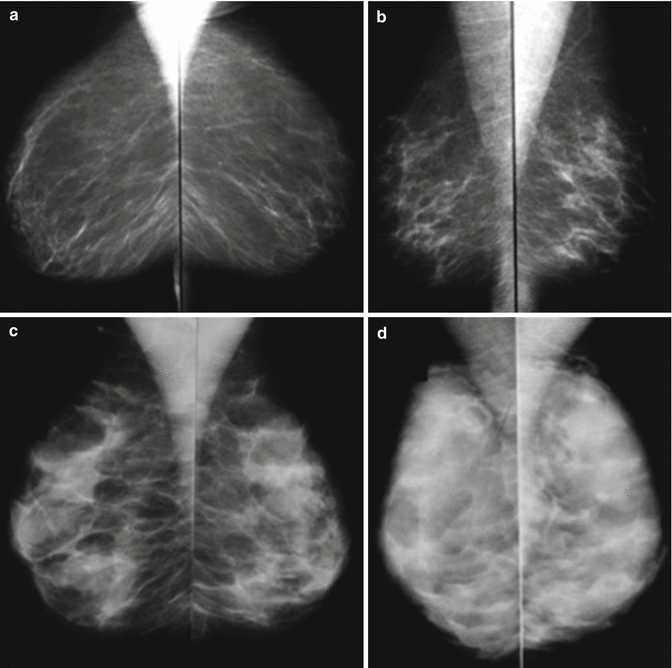
Fig. 17.1
The four-category ACR BI-RADS system for classifying mammographic density. The categories describe the fraction of fibroglandular tissue in the breast as judged by an observer and are (a) <25 %, (b) <50 %, (c) <75 %, and (d) >75 %
BI-RADS ACR b: there are scattered areas of fibroglandular densities with dense tissue less than 50 % (Fig. 17.1b).
BI-RADS ACR c: the breasts are heterogeneously dense with dense tissue less than 75 % that could obscure small masses (Fig. 17.1c).
BI-RADS ACR d: the breasts are extremely dense breast with more than 75 % dense tissue, which lowers the sensitivity of mammography (Fig. 17.1d).
Subjective visual assessment is used to assign an overall breast composition rating to convey the likelihood of lesion obscuration, but this is not a standardized method, with several studies reporting only moderate interobserver agreement [45–47]. Therefore, computer-based quantitative and objective methods of density measurement have been developed. Quantitative breast density measurement methods provide a reproducible, calculated density percentage (either the area or the volume, depending on the method used) assessed either semiautomatically or fully automatically by a computer program using either a 2D or 3D approach. The density percentage is determined by dividing the calculated area (or volume) of the fibroglandular tissue by the calculated total breast area (or volume). The most commonly used 2D approach to calculate the area of density percentage is the semiautomated, interactive, thresholding technique (the Cumulus™). Through the software application of interactive gray-level thresholding values to digitized mammograms, this method allows the separation of mammographically dense tissue from fatty tissue and, thus, calculates the area of density percentage [26, 43]. The interactive thresholding method is not completely objective because it requires user input (Fig. 17.2).
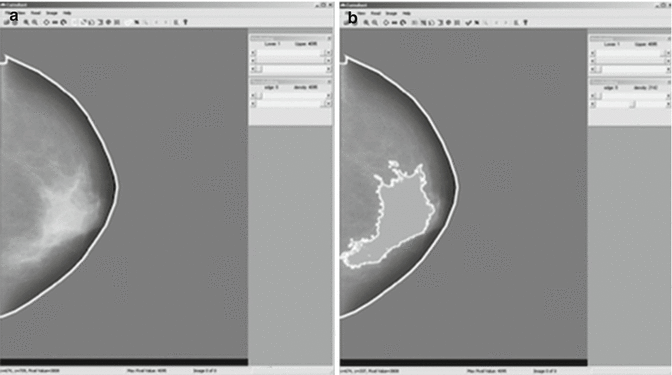

Fig. 17.2
The user interface for the interactive thresholding method for the determination of mammographic density (Cumulus ™). (a) The digitized or digital mammogram is displayed on the computer screen, and a threshold is selected by the operator to segment the breast from the surrounding background. (b) A second threshold is set to identify the regions of density. The algorithm indicates these pixels by a white overlay (Reproduced from Johns et al. [48])
Mammographic breast density measurement can be performed in 3D as well by directly assessing the “volume” or fractional volume of dense tissue. These methods create a physics model of the complete image-forming system, including the X-ray source, X-ray scattering and scatter removal, and the image receptor, and calculate a quantity which is referred to as the thickness of “interesting” fibroglandular tissue.
Currently, software programs (Table 17.4), approved by the US Food and Drug Administration (FDA), are available and provide fully automated volume density percentages that can be eventually converted to the appropriate BI-RADS density category [49–53].
Table 17.4
Quantitative assessment methods for breast density on mammography
Assessment type | Method | Device name | Specifics |
|---|---|---|---|
Calculation of area density percentage | Semi-automated | CUMULUS™ University of Toronto, Canada | Interactive thresholding |
QUANTRA™ Hologic, Bedford, MA, USA | Fibroglandular density per pixel is estimated by using known image-acquisition parameters, including breast thickness; the pixel values are then added to determine the volume of the fibroglandular tissue | ||
Calculation of volume density percentage (breast segmentation) | Completely automated | VOLPARA™ Matakina Technology Limited, Wellington, New Zealand | Pixel value representing fat is identified automatically by the software to provide a reference value; individual pixels in the breast are compared with the reference value to determine X-ray attenuation and generate a density map; the volume of the fibroglandular tissue and the total breast volume are calculated by adding the corresponding pixel value |
The main drawback of all the existing breast density assessment methods is that they are based on mammography, a technique that requires the use of ionizing radiation, as well as strong compression of the breast, which is often uncomfortable or even painful for the patient. Mammography is a 2D method by which to assess the breast, which is a 3D structure, and therefore, mammography will never be able to give an accurate absolute account of breast density, but rather a rough estimate.
17.3.1.2 Amount of Fibroglandular Tissue and Background Parenchymal Enhancement on Magnetic Resonance Imaging
The amount of fibroglandular tissue (FGT) refers to the composition of the breast, specifically the volume of non-fatty normal parenchyma assessed on MRI [54]. Thus, FGT greatly correlates to mammographic density and may provide superior accuracy in the determination of breast cancer risk [55–57].
MR imaging, with the administration of contrast media, reveals the enhancement kinetic features of normal parenchymal tissue, which is considered to reflect hormonal stimulation and proliferative activity. Background parenchymal enhancement (BPE) is defined as the intensity of FGT enhancement in the early phases of the dynamic contrast-enhanced examination [58, 59]. It has been shown that BPE and, to a lesser extent, also FGT are hormonally responsive features that decrease over time with the effects of menopause, after oophorectomy, and in women who underwent treatment with tamoxifen or aromatase inhibitors [60, 61]. However, BPE is not necessarily positively associated with FGT nor has a strong correlation been shown with mammographic breast density [62, 63]. Initial research by two case-control studies in high-risk screening patients have demonstrated that BPE can be a predictive biomarker of breast cancer risk in these patients. In women who have already been determined to be at high risk, in particular, marked BPE increases the individual breast cancer risk up to tenfold [58, 64]. In addition, BPE is considered to possibly decrease the sensitivity of breast MRI by obscuring enhancing malignancies or may diminish the specificity by causing enhancement patterns that overlap with the appearance of cancers [62, 65]. However, cross-sectional studies demonstrated no major increase in either false-positive or false-negative MR findings due to BPE [59, 66].
Recently, there have been attempts to measure breast density with MRI. A qualitative assessment of both FGT and BPE is possible by following the BI-RADS classification descriptors [44]. Analogous to breast density, FGT can be classified as follows:
BI-RADS a: the breasts are almost entirely fatty (Fig. 17.3a).
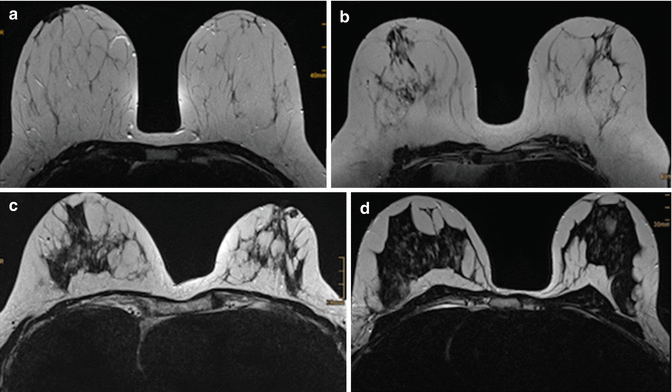
Fig. 17.3
The four-category BI-RADS system for classifying fibroglandular tissue. The categories describe the fraction of fibroglandular tissue in the breast and are (a) a, (b) b, (c) c, and (d) d
BI-RADS ACR b: there are scattered areas of fibroglandular tissue (Fig. 17.3b).
BI-RADS ACR c: heterogeneous fibroglandular tissue (Fig. 17.3c).
BI-RADS ACR d: extreme fibroglandular tissue (Fig. 17.3d).
BPE can be classified in congruence with the BI-RADS lexicon according to the different level of appearance (from minimal to marked) and to the distribution within the breasts (symmetric or asymmetric) (Fig. 17.4). Because it is a cross-sectional imaging technique that provides 3D images of the breast, MR imaging provides images that are related to the fat and water composition of the breast. Since the water composition is highly correlated with the prevalence of fibroglandular tissue, these images can be used for the slice-by-slice segmentation of the fibroglandular and fatty tissues for quantitative breast density assessment [57, 67, 68]. Multiple studies employing semiautomated algorithms have focused on the evaluation of the amount of FGT, demonstrating that breast MRI assessment of percent density correlates well with mammographic measures of percent density [33, 55, 56]. The current research on breast density measurement with MRI has been based on conventional T1-weighted sequences [33, 55, 56], which does not allow a fully automated separation of fatty and fibroglandular tissue due to the relatively small contrast between those two tissues. T1-weighted sequences provide gray-scale images, and therefore, the definition of a threshold by a radiologist is required to enable calculation of breast density. This human-defined threshold is a source of variability and poor sensitivity. A different approach, with the use of different sequences, has been recently proposed [69]. The Dixon technique represents an alternative to T1-weighted sequences for a fully automated, user-independent, MRI-based, quantitative volumetric breast density assessment. Dixon sequences are based on chemical shift imaging and, thus, are best suited for fat suppression in tissues containing similar amounts of lipid and water (e.g., fibroglandular tissue) [70–72] (Fig. 17.5). These sequences are fast and allow reliable and reproducible fat and water separation, and thus, a fully automated segmentation of fibroglandular and fatty breast tissue for breast density calculation is possible (Table 17.5).
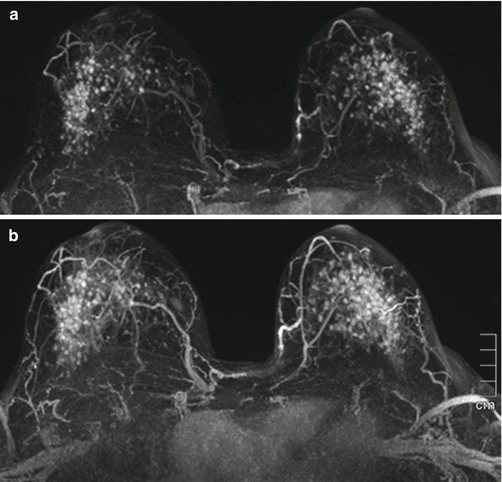
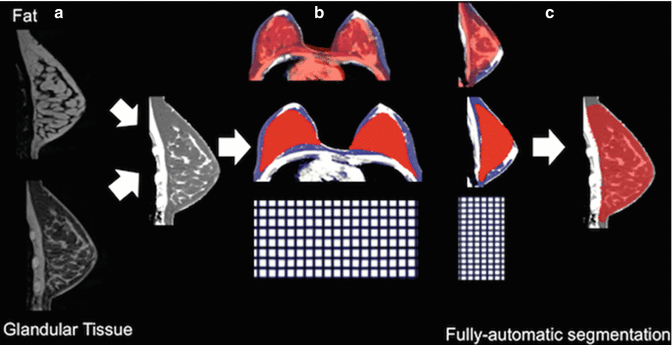

Fig. 17.4
A 44-year-old woman showing marked and symmetric nodular background parenchymal enhancement (BPE) described using the BI-RADS lexicon. (a) Maximum intensity projection (MIP) image after 2 min from injection of contrast agent, (b) MIP image after 8 min from injection of contrast agent

Fig. 17.5
Illustration of the automatic segmentation process of the breast. (a) The fat- and water-weighted Dixon images of the target subject are combined into a single image.(b) The template breast image (red overlay) with similar size and shape is registered to the subjects breast until both matched (bottom). (c) The deformation obtained from the registration process is applied on the associated manual template segmentation (red), resulting in an automatic segmentation of the target breast (bottom), excluding skin and the pectoralis muscle
Table 17.5
Interquartile ranges (25th to 75th percentile) of quantitative MG % BD estimation and the AQV MR % BD measurement system for each qualitative ACR BI-RADS BD category and the corresponding number of women
ACR | MG (IQR) | MRl (IQR) |
|---|---|---|
ACR 1 (0–24 %) | 8.42–33.84 % (mean 22.48 %) | 3.47–7.84 % (mean 7.84 %) |
ACR 2 (25–49 %) | 26.71–41.38 % (mean 35.26 %) | 7.84–25.88 % (mean 15.62 %) |
ACR 3 (50–74 %) | 41.99–63.86 % (mean 50.39 %) | 26.25–44.15 % (mean 34.42 %) |
ACR 4 (75–100 %) | 61.75–79.91 % (mean 70.14 %) | 39.86–71.20 % (mean 49.74 %) |
17.3.2 Tumor Characterization and Prognosis for the Hallmarks of Breast Cancer with Magnetic Resonance Imaging (MRI)
The hallmarks of cancer are all the biological capabilities acquired during the multistep development of tumors which reflect genetic alterations that drive the progressive transformation of normal human cells into highly malignant derivatives [73, 74]. They include sustaining proliferative signaling, evading growth suppressors, resisting cell death, enabling replicative immortality, inducing angiogenesis, and activating invasion and metastasis [73–77]. Recently, other hallmarks have also been reported, such as deregulating cellular energetics and avoiding immune destruction, and these processes play a central role in the pathogenesis of cancers [73] (Fig. 17.6). Tumors are, therefore, complex tissues consisting of multiple different cells that contribute to the development and expression of distinctive and complementary capabilities and which enable tumor growth and metastatic dissemination [73–77].
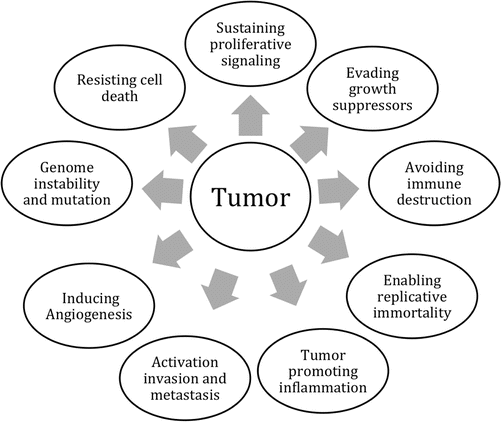

Fig. 17.6
The hallmarks of cancers. The capabilities of cancer involved in tumor growth and progression of some and perhaps all cancers (Modified from Hanahan et al. [73])
The understanding of these dynamic variations is crucial to improve tumor characterization and to develop new target therapies. However, a reasonably complete depiction of the network of microenvironmental signaling interactions is still far from complete, as the great majority of signaling molecules and pathways remain to be identified [73]. To elucidate these complexities of neoplastic disease, imaging techniques have to be equally sophisticated and multilayered. MRI may provide a wide range of information for the detection and characterization of tumors as well as insight into monitoring the response to treatment [78–85]. MRI could provide excellent contrast because of variations in water proton density and relaxation times (which reflect macromolecular content) and provide the ability to probe abnormal vessel permeability, tissue microstructure (diffusion imaging), and chemical composition (e.g., concentration of amides or lipids, or metabolites) [86–88]. Furthermore, the use of quantitative measurements from MR images contributes to reporting and monitoring specific biological changes: for example, a decrease in vascularity as a result of antiangiogenic treatement or an increase/decrease in cell density as biomarker of changes in proliferations and an increased lactate production as an indicator of anaerobic metabolism indicator [88]. Thus, MRI assays tumor characteristics and provides a means to noninvasively characterize tumors for prognostication, for individualization and optimization of treatment, and for monitoring therapeutic response. In the next subchapters, we will focus on the currently available MR techniques that allow the assessment of some of the aforementioned hallmarks of breast cancer.
17.3.2.1 Imaging of Tumor Neoangiogenesis with Dynamic Contrast-Enhanced Magnetic Resonance Imaging (DCE-MRI)
The hallmark of tumor growth and metastatic potential is neoangiogenesis, expression of dedicated vasculature that supports the high metabolic demand for oxygen especially of aggressive tumors [79, 89, 90]. Specific peptide hormones released by cancer cells promote the increased neoangiogenesis as soon as they exceed 2 mm [90, 91]. Being a limiting factor for both tumor growth and metastases, it has been assumed that angiogenesis correlates with tumor aggressiveness [92]. In particular, it has been widely demonstrated that microvascular density (MVD) (i.e., the number of endothelial clusters in a high-power microscopic field) correlates with the presence of metastases at time of diagnosis and with decreased patient survival times. Compared to conventional imaging, dynamic contrast-enhanced magnetic resonance imaging (DCE-MRI) has been so far the most sensitive method for detection of breast cancer with a negative predictive value ranging between 89 and 99 % in general [5, 78, 93–95]. Breast DCE-MRI can be used in preoperative and postoperative staging, in screening settings of women at high-risk, in patients with cancers of unknown primary (CUP) syndrome, and as a reliable problem-solving tool to accurately excludes malignancy [82, 83, 96]. This high sensitivity technique allows the detection of lesions visible only on breast MRI, while several authors advocate its false-positive rate that varies but is consistently higher than that of conventional imaging [78]. As the causes for false-positive findings are known – small and non-mass lesions [97] – protocols that focus on improving temporal and spatial resolution at field strengths of 1.5 and 3 Tesla showed their feasibility but did not focus on the problem makers in breast MRI yet [72, 98, 99]. High-field 7-T MR imagers also were introduced to offer even higher temporal and spatial resolution imaging because of the increased intrinsic signal-to-noise ratio [100–102]. However, with appropriate techniques and experienced readers, specificities not lower than 80 % can be achieved using breast DCE-MRI at any fields (1.5, 3, 7 T) [79, 83, 99]. DCE-MRI of the breast highlights lesions after intravenous injection of a contrast agent based on morphologic assessment and the enhancement characteristics of lesions [100–102]. The enhancement of a lesion is closely related to the microscopic vascular architecture as the agent is injected intravenously and washes in into the lesion via sprouted vessels [79, 89]. DCE-MRI is able to visualize tumor vasculature as a tumor-specific feature derived from angiogenesis [96]. Neoangiogenetically introduced vessels typically presents abnormal vessel permeability that is mediated by cytokines. Microstructural tissue properties can be characterized through assessing kinetic enhancement curves obtained from DCE-MR imaging [103]. To assess these, low molecular contrast agents on gadolinium basis that are not actively metabolized in the human body and that do not enter the intracellular space are intravenously injected as a rapid bolus. The distribution in the examined tissue is measured by repetitive T1-weighted sequences with preferably high temporal resolution. Signal intensity time curves can be measured either visually, per regions of interest or pixelwise parametric mapping [104, 105]. Biological factors influencing these curves in breast lesions are microvessel density, permeability, and extracellular leakage space [106, 107]. The percentage of maximal signal increase correlates well with the microvessel count [108–110].
In addition to semiquantitative assessment approaches, quantitative evaluation of contrast kinetics can be performed through pharmacokinetic modeling techniques. Contrast media exchange between the intravascular and the interstitial space, providing a measure of tumor blood flow, microvasculature, and capillary permeability. The most commonly used pharmakokinetical model introduced by Tofts et al. can be used to interpret signal intensity time curves. The initial phase describes tissue perfusion (e.g., the exchange between plasma and interstitium (K trans) that is influenced by microvessel density and permeability); the delayed phase is associated with the leakage space that is the extracellular extravascular space, described by the interstitial space volume fraction (v e). The higher tissue perfusion, the higher the initial enhancement; the lower the extracellular distribution space, the faster the maximum possible concentration of contrast agent is reached, leading to a transport from the extravascular extracellular space back into the vasculature, causing a washout of the contrast medium. The preferable quantification of DCE-MRI data is limited by a number of technical and biological influence factors on signal intensity time curves, e.g., scanner type and field strength and homogeneity, acquistion sequence parameters and timing, contrast injection, contrast material, and intra-individual circulation differences [104, 111]. The optimal pharmacokinetic approach deriving model parameters from nonlinear regression analysis of signal intensity time curves has not been determined yet, a fact underlined by a wide variety of models and model variations [112]. To perform DCE-MR imaging pharmacokinetic modeling and calculate quantitative parameters, two parameters should preferably be evaluated: precontrast T1 relaxation times of the tumor or tissue and the arterial input function (AIF). Precontrast T1 mapping requires acquisition of additional series of images with varying flip angle or inversion recovery sequences leading to inaccuracies due to B1 inhomogeneity especially at high field strengths [113]. This approach implicates additional minutes to the overall examination; thus, it is time-consuming [79, 103]. Most models require that the AIF be measured directly for each subject [106, 114], which is often challenging to perform and sensitive to patient motion between dynamic acquisitions. The most common approach was proposed by Huang and colleagues [114]. The authors proved the accuracy of an average AIF, i.e., shutter-speed approach calculated from a larger population for whom the injection site, dose, and rate were kept constant, with standard approach DCE-MR imaging pharmacokinetic analysis for breast cancer diagnosis. Yankeelov and colleagues [115] have proposed another method, estimating the AIF using a reference region model and found that such an approach correlated well with direct AIF measurement. Although model-based pharmacokinetics are challenging and time-consuming, they have the potential advantage over semiquantitative assessments of providing standardized measurements [116]. As discussed elsewhere in detail, pharmacokinetic modeling of DCE-MRI data is not as robust as often suggested [112]. In clinical practice, semiquantitative analysis of kinetic features in a breast lesion is usually measured using modest temporal resolution with at least 2 to 3 post-contrast T1-weighted acquisitions, with k-space centered at approximately 90–120 s after contrast injection for the first post-contrast images [103].
Tumor Characterization
By the pharmacokinetic information on tissue vasculature available through DCE-MRI, breast lesions can be characterized noninvasively: a highly vascularized and highly proliferative cancer with a relatively low extracellular, extravascular space will show a fast signal increase (reflected by high ktrans or plasma flow values), followed by an early signal decrease, the typical washout curve (quantified by a low ve or distribution volume). On the other hand, poorly vascularized benign lesions with a high extravascular extracellular space will show a slow (relfected by low ktrans or plasma flow values) and persistent (reflected by high ve and distribution volume values) signal increase. Depending on the underlying pathology, variations of these characteristics occur (Fig. 17.7). These basic phenomena were first described by Kaiser [117, 118]. Empirical evidence for quantitative DCE-MRI in breast lesion characterization is difficult to assess in general due to the wide variety of approaches. Huang and colleagues [114] found that low Ktrans values could avoid biopsy and proposed a potential Ktrans cutoff to decrease false-positive MR examinations. Li and colleagues [119] evaluated the value of morphologic examination in conjunction with dynamic contrast-enhanced MRI (DCE-MRI) for more precise diagnosis of breast cancer, as well as their correlation with angiogenesis and proliferative activity. They found that Ktrans and kep values were significantly higher in invasive ductal carcinoma and DCIS than ductal dysplasias.
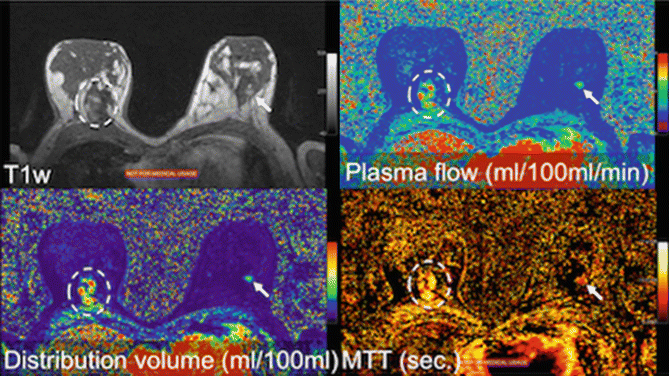

Fig. 17.7
DCE-MRI scan of a 48-year-old woman presenting with two lesions. DCE-MRI data was acquired using a 1.5 T device with a 16-channel dedicated bilateral breast coil at a temporal resolution of 6 s. at full breast coverage with a spatial resolution of 1.5 by 1.5 by 1.5 mm. Two nonpalpable lesions are present. The bigger lesion in the right breast (dashed circle) shows a high perfusion (plasma flow map, upper right), while the distribution volume is also high (upper left) as reflected by a long mean transit time (MTT, lower right). This combination is rather atypical for a malignant lesion; here, one would expect a high plasma flow, a low distribution volume, and a low mean transit time in such lesions. Biopsy revealed a highly vascularized fibroadenoma, consistent with the DCE-MRI findings. The smaller lesion on the left side (white arrow) shows an intermediate plasma flow, combined with an intermediate distribution volume and a low mean transit time. Findings are in line with a malignant lesion showing intermediate proliferation rate. In case of a fibrous fibroadenoma, one would expect a high distribution volume and longer MTT. Histology revealed a hormonal receptor-positive G2 invasive ductal carcinoma
The official BI-RADS approach is a simplification of the pharmacokinetic approach, accounting for inconsistent techniques used worldwide: the initial enhancement is classified as either slow, intermediate, or fast and the delayed enhancement curve type as either persistent, plateau, or washout. A highly aggressive cancer will thus present with a fast washout curve, while a slow-growing invasive lobular cancer can present a slow and persistent enhancement [44, 104]. However, considerable overlap of semiquantitative kinetic curve types among benign and malignant lesions exists [120]. Plateau curves might be seen in both malignant and benign lesions and are thus not decisive for differential diagnosis [80, 117, 121–124]. Rarely, washout can be associated to benign conditions, such as papilloma [125]. Furthermore, less common subtypes of invasive breast cancers, such as inflammatory carcinomas or lobular carcinomas, can show an enhancement pattern, which differs from the classical malignant type. Lobular invasive cancer demonstrates a washout enhancement pattern less frequently compared to invasive ductal cancer [79, 126]. Ductal carcinoma in situ (DCIS) is a biologically very heterogeneous entity exhibiting highly heterogeneous enhancement patterns with varying kinetic characteristics: in only 61–69 % of the DCIS lesions, a washout pattern has been found [127–129]. Evaluation of enhancement patterns in lesions suspicious for DCIS is, therefore, not regarded as a reliable basis for their differential diagnosis [130].
Tumor Prognosis
Despite improving delineation between benign and malignant lesions, enhancement analysis correlates also to prognostic factors [131]. Specifically, a number of studies have demonstrated that high-grade breast cancers or triple-negative cancers show different perfusion parameters, namely, stronger and faster initial enhancement and higher rate of washout compared with low-grade breast cancers or luminal-type cancers [92, 108, 114, 132]. These surrogate markers hint at a poorer prognosis, and their connection to DCE-MRI parameters let assume that also DCE-MRI is a direct biomarker for breast cancer patient’s outcome. Baltzer et al. could demonstrate a direct connection between computer-assisted quantification of a breast cancer lesion’s worst washout and the individual risk of developing metachronous metastases [133] (Fig. 17.8). They could differentiate a group from patients at very low risk from patients at risk of developing metastases. It does then not astonish that other authors showed that disease-specific survival in breast cancer is associated to more malignant enhancement kinetics [131, 132, 134–137].


Fig. 17.8
Direct association between DCE-MRI and patient outcomes as demonstrated by Baltzer et al. [133]: (a) computer-assisted semiquantitative lesion analysis. Every voxel passing an initial threshold for early enhancement is color coded according to its initial enhancement and delayed enhancement curve type following BI-RADS criteria. The computer then automatically detects the most suspicious washout curve in the yellow rectangular volume of interest indicated by the user. Curve types are extracted, reflecting tumor biology (b): a breast cancer with higher proliferative activity and microvessel density (confirmed by immunohistochemical staining in this example) shows a more aggressive curve type (red) as compared to a less vascularized cancer (green). Baltzer et al. demonstrated that by the semiquantitative amount of washout, patients at high-risk for developing metachronous metastases (c, red) could be differentiated from low-risk patients (c, green)
Therapy Monitoring
Another application of DCE-MRI is in women receiving neoadjuvant chemotherapy. It has been demonstrated that MRI is superior to clinical assessment and conventional imaging in measuring response to treatment and in predicting pathologic complete response (pCR) [138]. MRI has the unique ability of a volumetric evaluation of tumor size as well as a quantitative assessment of enhancement, which is reflective of the intra-tumoral microvascularization. As this vascularization is responsive to neoadjuvant therapy, a number of reports have demonstrated that DCE-MRI provides diagnostic information to assess breast cancer response to treatment (Fig. 17.9). Regarding quantitative pharmacokinetic parameters, decreases in ktrans [139, 140], kep [140, 141], and the relative initial enhancement [139, 141] are associated with treatment response. Recently, it has been demonstrated that simple analysis of enhancement curve types contains similar accurate diagnostic information for prediction of treatment response as compared to more advanced pharmacokinetic parameters. Although not fully quantitative by nature, simple time curve-type analysis is faster and does not require complex post-processing [142]. It should be mentioned that besides technical factors, several additional criteria could influence the accuracy of DCE-MRI in the neoadjuvant setting. The intrinsic molecular subtypes show distinct different responses [143–145], and also the prediction of pCR is related to the molecular subtypes. HER2-positive and triple-negative cancers more often demonstrate a complete response than hormone receptor-positive breast cancers [146–148]. Additionally, the accuracy of the assessment of response to neoadjuvant chemotherapy with MRI is dependent on the type of neoadjuvant chemotherapy regimen used. For instance, taxane-containing chemotherapy has an antiproliferative and antiangiogenesis effects, thus reducing contrast enhancement of both benign and malignant breast lesions and even the BPE [149].
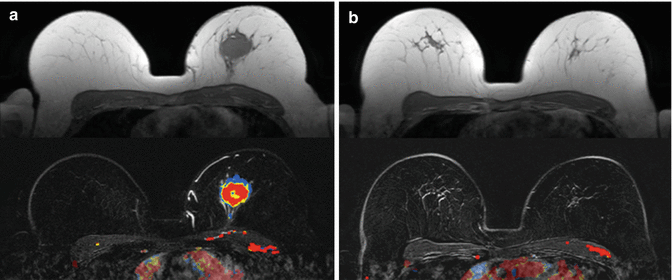

Fig. 17.9
MRI before (a) and after (b) neoadjuvant chemotherapy in a 51-year-old patient with her-2-enriched breast cancer. The parametric map of semiquantitative enhancement curve types defined by relative initial enhancement (signal intensity) and relative washout (color) shows a highly aggressive breast cancer lesion before treatment (a), demonstrated by a high percentage of bright red voxels, corresponding to fast washout enhancement curves. After chemotherapy, the lesion shows a substantial reduction in size, combined with the absence of any threshold-passing enhancement indicated by the absence of color-coded voxels on the parametric map
In conclusion, there is broad consensus in the literature concerning the diagnostic value of DCE-MRI measurements for noninvasive characterization and prognostication of breast lesions as well as for therapy monitoring in breast cancer patients undergoing neoadjuvant therapies. However, the broad variety of methodologies to analyze dynamic enhancement data does yet preclude cutoff recommendations that could be used in prospective studies or in everyday clinical practice.
17.3.2.2 Imaging of Tumor Microstructure with Diffusion-Weighted Magnetic Resonance Techniques
Diffusion-Weighted Imaging (DWI)
Diffusion-weighted imaging (DWI) quantifies the random, microscopic motion of protons in tissues (i.e., Brownian movement) and noninvasively describes tissue microstructure in vivo [150]. Tumor tissue is characterized by a high cellular density, due to the increased cellular turnover, and by a high proteolytic activity which enables cancers to degrade the tissue structure and spread unhindered through adjacent tissues. DWI is able to show the degree of water diffusion in tissue that is inversely correlated with tissue cellularity and the integrity of cell membranes [151, 152]. Tumor cells, and the chronic inflammatory reaction to proteolysis through desmoplastic tissue changes, lead to a relative or absolute reduction in extracellular water content, thus limiting extracellular water diffusion [152, 153]. Molecular diffusion can be calculated by assessing the signal attenuation that occurs at least at two different b values, depending on the timing and amplitude of diffusion gradients, to measure what is known as the apparent diffusion coefficient (ADC) value in square millimeters per second. ADC is defined as the average area covered by a molecule per unit time [84, 150] and closely reflects biological tumor characteristics, such as cellularity and water content. Typically, low ADC values in breast tissue are associated with malignancy as a result of the increased restrictions in water diffusion in highly cellular regions, in contrast to normal glandular tissue or nonrestricted diffusion in cysts [154–156]. In biological tissue, microscopic motion from diffusion and perfusion both contribute to ADC. However, microstructural changes that influence water diffusion in neoplastic breast tissue are still poorly understood [151]. ADC values derived from DWI are also strongly influenced by the choice of b value. Bogner et al. [157] compared the diagnostic quality of different DWI protocols with regard to ADC accuracy, ADC precision, and DW contrast-to-noise ratio (CNR) for different types of breast tumors. Those authors found that the optimum ADC determination and DWI quality could be achieved with a combination of b value protocol of 50 and 850 s/mm2 (Fig. 17.10). This provided diagnostic accuracy of 96 % for differentiation of benign and malignant breast tumors. A systematic meta-analysis from Dorrius et al. [158], evaluating 26 published articles on DWI studies, confirmed that the wide variety of b value combinations applied in different studies significantly affects the ADC of breast lesions. These investigators suggested the combinations of b = 0 and 1,000 s/mm2 to achieve the best improvement in differentiation between benign and malignant lesions. In general, the specificity of DWI is higher (75–84 %) than that achieved in DCE-MRI (67–72 %), especially when b values >600 s/mm2 are used. Prior studies have shown promising results from DWI images and ADC values over conventional DCE-MRI in the characterization of breast lesions and further proved that the additional use of DWI significantly improved the diagnostic accuracy of DCE-MR examinations [85, 159–161]. Various investigations [160, 162–164] have already pursued the idea of incorporating the ADC thresholds into the standardized system of reporting the breast imaging examinations (BI-RADS Breast Imaging Reporting And Data System) [44]. Partridge and colleagues demonstrated an improvement in diagnostic accuracy over DCE-MRI alone by using an ADC threshold combined to conventional MRI assessment. Namely, they demonstrated an improvement in PPV by using DWI combined with DCE-MRI, with a 33 % reduction of false positives. Pinker et al. [165] developed a BI-RADS-adapted system for breast MR imaging, useful in clinical practice, by improving significantly the specificity of the readers (89.4 %). Baltzer et al. [166] investigated the improvement in specificity of breast MRI by integrating ADC values with DCE-MRI using a simple sum score. The additional integration of ADC scores achieved an improved specificity (92.4 %) compared to DCE-MR only reading (specificity of 81.8 %), without causing false-negative results.
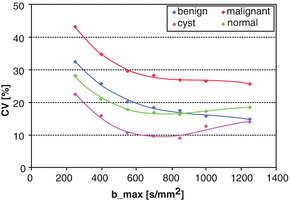

Fig. 17.10
Proper choice of bmax (polynomial trendlines) improves fitting precision, as illustrated by decreasing mean coefficient variation (CV). ADC calculation precision improves only slowly for benign or malignant lesions with b values higher than 850 mm2/s, while both normal tissue and cysts showed maximum precision at this point (Reproduced from Bogner et al. [157])
Tumor Characterization and Prognosis
DWI and ADC values have demonstrated an excellent ability to differentiate benign and malignant breast lesions [151, 152]. A meta-analysis of 13 studies that evaluated the diagnostic performance of DWI in 615 malignant and 349 benign lesions reported a pooled sensitivity of 84 % (95 % CI, 82–87 %) and a specificity of 79 % (95 % CI, 75–82 %) [167]. Several authors have recommended cutoff thresholds to discriminate benign and malignant lesions [156, 168–171]. A very low ADC value (<1.2 × 10−3 mm2/s) is specific for malignancy (Fig. 17.11), and high ADC values (>1.4 × 10−3 mm2/s) are likely expected for benignity (Fig. 17.12). Intermediate ADC values are unspecific and, thus, less helpful in clinical practice. Rigid interpretation criteria, such as single cutoff values, are not feasible due to an overlap of ADC values in benign and malignant lesions. Analogous to serum blood markers, such as serum C-reactive protein concentrations, different levels of suspicion can be raised based on ADC values: low (likely benign), medium (indeterminate), and high (likely malignant) [166]. Thus, high ADC thresholds (>1.4 × 103 mm2/s) can reliably exclude malignancy and help to obviate unnecessary false-positive MRI-guided biopsies [172]. ADC values can also be used as a noninvasive imaging biomarker to predict the probability of cancer invasiveness [173]. Bickel et al. found that DCIS showed significantly higher ADC values (<1.24 × 10−3 mm2/s) compared to invasive cancers (<1.14 × 10−3 mm2/s). These results have great clinical implications, since they could result in a change in the management of noninvasive cancers, often overdiagnosed and therefore overtreated [174]. ADC values have also shown differences according to tumor subgroups. Martinicich et al. [175] found that breast cancers characterized by high cellularity (or a higher number of mitoses) showed a lower ADC value at DWI. It is also plausible that the median ADC values correlate to HER2/neu status, with ADC values significantly higher in the subgroup of HER2-/neu-enriched compared to HER2-/neu-negative tumors [168, 175]. Similar observations have been published in triple-negative breast cancers, associated with higher ADC values on DWI compared to ER+ and HER2-/neu-enriched tumors [21, 176–178]. In contrast, mucinous carcinoma usually presents ADC values similar to those of benign lesions (>1.4 × 10−3 mm2/s), most likely due to the presence of both low cellularity and mucin-rich compartments [179]. No significant correlation between ADC values and tumor grading has been found as yet [173, 180, 181].
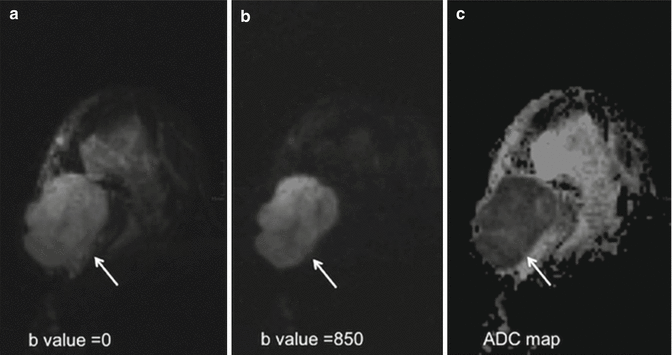
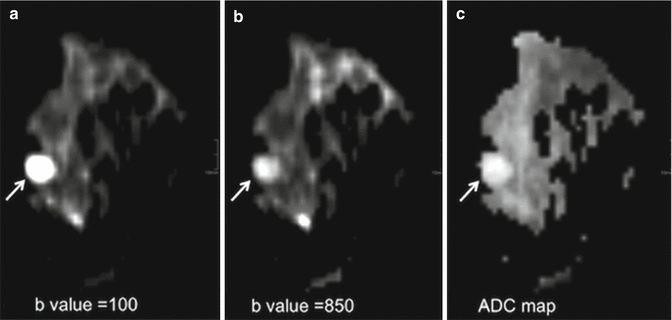

Fig. 17.11
Invasive ductal cancer G3 (triple negative) in (0.998 × 10−3 mm2/s) highly suggestive of malignancy a 29-year-old woman at 2 o’clock of the right breast. (a, b) (BI-RADS 5) The lesion is marked with an arrow. Diffusion weighing at different b values and the respective (c) ADC values

Fig. 17.12
Cystic lesion in a 45-year-old woman at 2 o’clock in the right breast. (a, b) Diffusion weighing at different b value. (c) The lesion (arrow) demonstrated ADC values (2.675 × 10−3 mm2/s) above the threshold for malignancy. The lesion was classified as BI-RADS 2 (benign)
Therapy Monitoring
DWI has been proposed as a “biomarker for treatment response in oncology” [12]. In patients undergoing anticancer therapy, ADC values are very sensitive to changes in tumor cellularity and necrosis, and early ADC changes in responding patients may predict tumor regression even months ahead of the currently employed imaging techniques [12, 182]. The cytotoxic effect associated with the administration of these agents increases the Brownian movements in the damaged tissues, reflecting an increase in ADC value that may appear earlier than lesion size changes [182, 183]. Park et al. [184] studied the potential of DWI in the prediction of response to neoadjuvant chemotherapy in patients with breast cancer and found that patients with breast cancer and a low pretreatment ADC tended to respond better to chemotherapy, yielding a sensitivity of 94 % and a specificity of 71 % when the ADC cutoff pretreatment was very low (<10−3 mm2/s). Richards et al. [185] evaluated the accuracy of ADC in predicting the response to neoadjuvant chemotherapy according to breast tumor phenotypes. In 118 women undergoing neoadjuvant chemotherapy for locally advanced breast cancer, the authors found that pretreatment tumor ADC values differed between intrinsic subtypes and were predictive of pathologic response in triple-negative tumors. However, the assessment of prechemotherapy ADC has yielded divergent results in the literature, and its role as potential biomarker for predicting the response to treatment in locally advanced breast cancer needs further validation [153, 182, 183, 186].
Advanced Methods of Breast DWI
Diffusion Tensor Imaging (DTI)
Considered as an extension of DWI, diffusion tensor imaging (DTI) provides information about water motion in six or more directions, characterizing the motion of water in more detail [86, 187]. DTI provides measurements of two parameters: mean diffusivity (MD) and fractional anisotropy (FA). MD reflects the average anisotropy, while FA describes the degree of anisotropy [87, 187]. The diffusion of water molecules in the mammary glandular/ductal system presents a particular example of restricted movement: free diffusion parallel to the walls of the ducts and lobules and restricted diffusion in the perpendicular directions, leading to an anisotropic diffusion [188]. Therefore, any changes of this tissue structure, through either benign or malignant tumor growth, should be reflected by changes in diffusion anisotropy [86, 187, 188]. Accordingly, based on histopathological knowledge, most breast diseases result in decreased structuring compared to healthy tissue. Partridge et al. [189] investigated whether DTI measures of anisotropy in breast tumors are different from those of normal breast tissue and whether these measures could improve the discrimination between benign and malignant lesions. They found that diffusion anisotropy is significantly lower in breast cancers than in normal tissue, which may reflect alterations in tissue organization, but cannot reliably differentiate between benign and malignant. Baltzer et al. [86] proved that DTI can visualize microanatomical differences between malignant and benign breast lesions as well as breast parenchyma, but FA did not show an incremental diagnostic accuracy compared to ADC (Fig. 17.13). Although the results concerning the diagnostic accuracy of FA are divergent [86, 159, 187], DTI has proven to be diagnostically relevant in cancer detection [86, 188, 189], having the potential to serve not only as an adjunct method to DCE examination but also as an alternative method when DCE imaging is contraindicated.
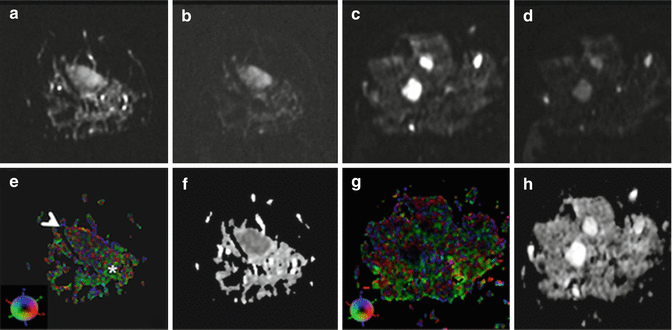

Fig. 17.13
(a–d) Comparing b 0 s/mm2 with the b 1,000 s/mm2 image in two different lesions, one malignant (a, b) and one benign (c, d). In both cases diffusion-dependent signal loss of fibroglandular tissue is stronger than that of the lesions. For the malignant lesion, the corresponding ADC map (f) shows low signal intensity. Color-coded FA map (e) shows the lesion (arrowhead) a little more hypointense compared to breast tissue (asterisk), the lesion does not have a predominant diffusion direction. These findings are typical for invasive breast cancer, which was verified by histopathology (invasive ductal cancer G2). For the benign lesion, the corresponding ADC map (h) shows high-signal intensity. Color-coded FA map (g) demonstrates very low anisotropy (hypo-intensity) inside the lesion without predominant diffusion direction. These findings are typical for fibroadenoma, which was verified by histopathology (Reproduced from Baltzer et al. [86])
Diffusion-Weighted Kurtosis Imaging (DKI)
Diffusion-weighted kurtosis imaging (DKI) is able to quantify the Brownian incoherent motion and microperfusion or blood flow that shows non-Gaussian phenomena [190], which are more characteristics of the diffusion-weighted MR signal in living tissues. Compared to DWI, DKI has demonstrated substantially higher sensitivity in breast cancer detection and characterization [191, 192]. By enabling differentiation and characterization of breast lesions and providing insights into microstructural complexity, DKI may be used as a biomarker for the prediction of histologic malignancy grade and proliferative activity of breast cancer. Sun and colleagues [192] investigated the diagnostic accuracy of DKI in assessing breast cancer clinicopathological factors. They found that the quantitative analysis of DKI-derived parameters significantly improved the specificity of the characterization of benign versus malignant lesions compared to ADC values and DWI. In addition, DKI correlated with tumor histologic grades and Ki-67 tumor expression. The authors also proved an increase in diagnostic accuracy when diffusivity and kurtosis were added to DCE-MR, enhancing the potential role of DKI in the management of breast cancer patient, especially in monitoring the response to treatment.
17.3.2.3 Imaging of Tumor Metabolism with Proton Magnetic Resonance Spectroscopic Imaging (1H MRS)
Proton magnetic resonance spectroscopic imaging (1H-MRSI) is a noninvasive diagnostic tool that enables the assessment of biochemical tissue properties and provides metabolic information about tumors [193, 194]. 1H-MRSI detects the choline peak at 3.2 ppm, which is not regularly identified in healthy breast tissue at field strengths of 1.5 and 3 T [195–198]. Choline metabolites, such as choline, phosphocholine, and glycerol-phosphocholine, simply referred to as total choline (tCho), are components of cell membranes [193, 199–201]. The increased levels of tCho detected in cancers can be explained by the increase in tumor cell turnover [154, 202–205]. It has been demonstrated that the additional application of 1H-MRSI helps in the characterization of breast tumors [206, 207] (Fig. 17.14). A variety of spectroscopic techniques at different field strengths can be used. Higher field strengths provide higher signal-to-noise ratios, and spectroscopic imaging allows spatially resolved examinations with small voxels [208]. Although a diagnostic benefit may thus be expected, comparison with studies at 1.5 T have not revealed such an advantage as yet [206].


Fig. 17.14
Invasive ductal carcinoma G3 in the 3 o’clock position of the left breast in a 40-year-old woman: (a) On proton magnetic resonance spectroscopic imaging, there was a choline peak at 3.2 ppm (signal-to-noise ratio 10.5). (b) Metabolic map (c) DCE-MRI demonstrated an irregularly shaped mass lesion with spiculated margins. The lesion was classified as malignant, BI-RADS_ 5 (highly suggestive of malignancy)
Baltzer et al. [209] estimated the diagnostic performance of 1H-MRSI in differentiating benign from malignant lesions in a recent meta-analysis of 19 studies, performed at 1.5 T and at 3 T. They found a pooled sensitivity and specificity of 73 % and 88 %, respectively, with a homogenous high specificity and a variable sensitivity in the studies (42–100 %). 1H-MRSI showed limitations in the diagnosis of early breast cancer and small breast tumors because of low sensitivity and heterogeneous performance in non-mass-like enhancing lesions. Gruber et al. [195] evaluated the diagnostic accuracy of a high-spatial-resolution 3D 1H-MRSI protocol at 3 T, designed to cover a large fraction of the breast in a clinically acceptable measurement time of 12–15 min, for the differentiation of benign and malignant breast lesions, on the basis of choline (Cho) signal-to-noise ratio (SNR) threshold levels. They concluded that 3D-MRS at 3 T is possible in patients with breast lesions, with excellent data quality, and has the potential to become a valuable adjunct to DCE-MRI for the differentiation of benign and malignant breast lesions. Furtherore, Pinker et al. [85] found that the additional value of 1HMRS to DW and DCE-MR yielded a diagnostic accuracy significantly higher than DCE-MRI and also resulted in the elimination of false-negative lesions and significantly reduced the false positives.
Qualitative and quantitative in vivo measurements of choline metabolites have been used as a diagnostic test in the work-up of neoplastic breast lesions [206]. Quantitative assessment of the recorded tCho, indicator of breast malignancy, can be performed either intra-voxel, with water used as an internal reference, or using an external standard. For accurate measurement of the relative amount of a metabolite, the resonance area (i.e., the calculated integral of the number of molecules measurable by 1H-MRSI) must be corrected for the relaxation properties of the signal and not overlap with any other resonances in the spectrum [207]. Qualitative assessment of the recorded tCho involves the subjective determination by an observer as to whether a distinct resonance at approximately 3.2 ppm is present [194]. The sensitivity of qualitative tCho detection, and hence, cancer diagnosis, is significantly decreased for smaller cancers, which might be diagnosed as benign due to insufficient tCho signal for detection [194].
Tumor Characterization and Prognosis
The human breast demonstrates a number of distinct resonances attributable to choline, glycerides (esters of fatty acids and glycerols), saturated and unsaturated fatty acids, and water. The variations in cellular metabolites that occur during tumor development can be monitored using 1H-MRSI [194, 196]. Malignant disease has a typical peak at 3.23 ppm, whereas benign lesions, such as fibroadenomas, have a resonance at the frequency of 3.28. The same spectrum can be seen in healthy volunteers and lactating women [203, 207]. Therefore, based on the different choline peaks, it is plausible to differentiate benign and malignant lesions and also use 1H-MRSI as a biomarker of tumor aggressiveness. Shin et al. [210] showed that tumor tCho measures were significantly higher for invasive ductal carcinoma versus in situ cancers and correlated with several prognostic factors, including nuclear grade, histologic grade, and estrogen receptor status. To date, tCho-containing compounds are not only considered for the expression of increased proliferation rather as general hallmarks of malignant transformation [200, 211]. Therefore, the role of 1H-MRSI for breast cancer risk stratification has been investigated [81, 212, 213]. Recently, Ramadan and colleagues [214] have proved that healthy breast tissue in patients who are carriers of a mutation in one of the two genes related to breast cancer (BRCA-1 and BRCA-2) is likely to differ from each other and from non-mutation carriers regarding levels of triglycerides, unsaturated fatty acids, and cholesterol, even in the absence of any other imaging findings. Further studies are needed to prove these hypotheses, which, if supported by comprehensive results, could open unique frontiers for the screening programs for high-risk women.
Therapy Monitoring
1H-MRSI of the breast is a promising tool for the assessment of the direct effect of anticancer agents. Jagannathan et al. demonstrated that, after completion of neoadjuvant chemotherapy, a change in the tCho concentration was observed and confirmed by histopathology [215–217]. Meisamy et al. [196] demonstrated that 1H-MRSI of the breast was able to detect a change in Cho concentration from baseline (before receiving therapy) within 24 h of administration of the first dose of the regimen. This change had a statistically significant positive correlation with a change in the final size of the lesion (p = 0.001). Therefore, it can be expected that the addition of 1H-MRSI of the breast will offer a substantial advantage over contrast-enhanced MRI of the breast alone in the prediction of response to neoadjuvant chemotherapy.
17.3.2.4 Multiparametric Magnetic Resonce Imaging
MRI of the breast is an established noninvasive imaging modality for the detection, characterization, and staging of breast tumors. DCE-MRI is the backbone of any given MRI protocol. DCE-MRI provides mainly morphologic and, to some extent, functional information, i.e., perfusion and vascular integrity, which results in an excellent sensitivity and good specificity [54, 99, 213, 218]. Recently, several functional MRI parameters have been assessed for breast imaging. Available data suggest that functional MRI parameters can provide detailed information about the cellular, microcellular, and subcellular biological systems and, thus, may provide additional specificity [54, 99, 103, 165, 208, 213, 218]. The combination of DCE-MRI and other functional MRI parameters is defined as multiparametric (MP) MRI. MP MRI of the breast simultaneously and noninvasively acquires multiple imaging biomarkers at different levels and, thus, has the potential to significantly improve breast cancer diagnosis, staging, and assessment of treatment response. In several recent studies, the diagnostic value of MP MRI using two parameters, i.e., DCE-MRI and DWI, was assessed. It was demonstrated that MP MRI with two parameters achieves an increased diagnostic accuracy in breast cancer diagnosis [103, 159, 162, 165, 166]. Recently Pinker et al. compared the diagnostic accuracy of DCE-MRI as a single parameter to MP MRI with two (DCE-MRI and DWI) and three (DCE-MRI, DWI, and 1H-MRSI) parameters in breast cancer diagnosis (Figs. 17.14 and 17.15). MP MR with three MRI parameters yielded significantly higher AUCs (0.936) compared to DCE-MRI alone (0.814) (p < 0.001). MP MRI with just two parameters at 3 T did not yield higher AUCs (0.808) than DCE-MRI alone (0.814). MP MRI with three parameters resulted in elimination of false-negative lesions and significantly reduced the false positives (p = 0.002). The authors concluded that MP MRI with three parameters increases the diagnostic accuracy of breast cancer compared to DCE-MRI alone and MP MRI with two parameters.


Fig. 17.15
Three‐dimensional (3D) ultrasound scan of a malignant breast lesion. The plane parallel to the array of the probe, equivalent to a conventional two‐dimensional picture, is displayed in the left upper quadrant. The reconstructed plane perpendicular to this plane is shown in the right upper quadrant and can be achieved in conventional ultrasound by a 90° turn of the probe. The “coronal” plane, parallel to the skin and depicted in the left lower quadrant, is unique to 3D ultrasound and cannot be achieved with a conventional probe. A strong retraction phenomenon is visible in this plane (Reproduced from Watermann et al. [219])
17.3.3 New Frontiers in Breast Imaging
17.3.3.1 Quantitative Imaging Biomarkers with Ultrasound
Ultrasound (US) is an established adjunct in breast imaging for further characterization of mammographically suspicious breast lesions, for lesion detection in women with dense breasts, and for the assessment of tumor response and is the method of choice in younger women, due to the lack of ionizing radiation [220–222]. B-mode US demonstrated a high diagnostic performance with high accuracy and sensitivity, but suffers from varying sensitivity, with ranges between 20.7 and 98.5 % [223–226]. In addition, interobserver variability in breast US examinations poses a further limitation [227, 228]. High-resolution 2D and 3D B-mode imaging allows an accurate depiction of anatomy and the pathomorphology of the tumor and its interactions with the surrounding tissue [219, 229] (Fig. 17.15). Automated 3D breast ultrasound (ABUS) has gained a lot of interest recently especially in screening of dense breasts, where the sensitivity of mammography is poor [230]. Although a promising tool for its high reproducibility [231], ABUS is time-consuming and subtle abnormalities may be missed [232, 233]. Apart from B-mode US, several US-based techniques have been implemented to collect functional and kinetic information about breast tumors [234, 235]. In the following paragraphs, we focus on these techniques, such as elastography, Color and Power Doppler (CD and PD), and contrast-enhanced US (CEUS). Furthermore, we briefly describe a new promising technology, i.e., molecular US imaging, as a method of noninvasive imaging of tumor angiogenesis using microbubbles targeted to molecular markers as contrast agents [236, 237].
Elastography
The use of elastography in breast ultrasound is based on the fact that different tissues are expected to respond differently based on the amount of compression [225, 238, 239]. Generally, breast cancer tissue is harder than the adjacent normal breast tissue [238]. Given that compression of the breast using a probe results in displacement (strain) of the underlying tissues, stiffer tissues are expected to present a smaller strain than softer ones, and thus, calculation of the strain induced by probe compression can help differentiate stiffer from softer components, namely, breast cancer from surrounding healthy breast parenchyma [223, 224, 238]. Elastography allows the assessment of qualitative and quantitative information about solid breast lesions [83]. To characterize breast lesions and to allow differentiation between malignant and benign lesions, Itoh et al. [238] introduced a five-point elasticity score. The authors found that cutoff points between 3 and 4, to rule out malignancy, yielded a sensitivity of 86.5 % and a specificity of 89.8 %. Further efforts have been made in order to quantify the elastographic results, using strain ratio (i.e., the fat-to-lesion ratio, indicating the stiffness of a lesion) [240] and shear wave (SW) elastography. Strain elastography calculates the degree of deformation (strain) in a direction perpendicular to the tissue surface in response to an externally applied force and, thus, is limited by significant interobserver variability [239, 241]. SW elastography is less user dependent, with better reproducibility, because the operator does not apply any kind of pressure on the breast, and a short duration, high-intensity acoustic “pushing pulse” is used for tissue compression instead [242–244]. Then, either a series of diagnostic intensity pulses, used to track the subsequent displacement of the tissue (acoustic radiation force impulse (ARFI) technology), or a very fast US acquisition sequence that captures the propagation of shear waves (supersonics imaging) follows the “pushing pulse” [245]. Both technologies provide quantitative measurements of tissue stiffness, either in m/s of SW velocity (ARFI) or in kPa (supersonics).
Tumor Characterization and Prognosis
Several authors have proved that elastography can help characterize breast lesions [229, 240, 242]. Ophir et al. [246] first described the potential use of elastography to differentiate breast cancer from benign lesions. Garra et al. [247] presented the first clinical study about the value of elastography in distinguishing benign and malignant diseases of the breast and reported a sensitivity of 100 % and a specificity of 56 % for solid breast lesions. The two most important strain elastographic characteristics in evaluating breast lesions are size and stiffness criteria. Invasive breast cancers have been shown to be stiffer than benign or normal tissues and, thus, measure larger and darker than they do on corresponding B-mode images [248]. Fibroadenomas, softer than malignant lesions, appear smaller in size and brighter than on the B-mode image [241]. However, fibroadenomas sometimes have elastographic size or stiffness features that are more typical of malignancy. Such false-positive elastographic findings tend to occur in fibroadenomas that are larger than 2 cm and contain calcification [249]. Areas of ductal carcinoma in situ (DCIS) have static elastography values that fall between those seen in invasive cancer and in fibroadenomas. SW provides a color map of tissue elasticity that is superimposed on the real-time gray-scale ultrasound images, to provide a general overview of the examined area. SWs travel faster in stiffer tissue, and thus, the velocity measurements in ARFI imaging (Fig. 17.16) can help differentiate between benign (softer, lower SW velocity) and malignant lesions (stiffer, higher SW velocity). The quantitative data are also presented in the form of a color-coded map, which is superimposed on the B-mode images to provide a general overview of the examined area. Several studies have demonstrated positive results for the differentiation of benign and malignant lesions [225, 250], although the proposed cutoff values are quite divergent. Recently, ARFI technology has also demonstrated, in a preliminary study [251], a cutoff value of 3.23 m/s to show a sensitivity of 82.4 % and a specificity of 80.4 % in the differentiation of benign and malignant breast lesions. Further studies are needed to validate these promising results.
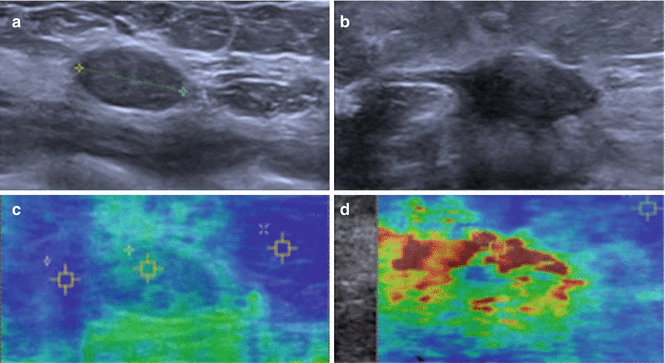

Fig. 17.16
ARFI: (a–c) Fibroadenoma in a 35-year-old woman on the right breast. (a) On conventional B-mode image, lesion was classified as BI-RADS category 3. (c) On elasticity image, the hypoechoic lesion was blue and green, indicating a softness. (b–d) Invasive ductal carcinoma G2 in a 50-year-old woman on the right breast. (b) On conventional B-mode image, lesion was classified as BI-RADS category 5. (d) The diagnostic hypothesis was confirmed due to the hardness of the tissue hypoechoic lesion, red and yellow areas
Therapy Monitoring
Both strain and SW elastography might add information to help predict tumor response to neoadjuvant chemotherapy [242, 252] and for monitoring the response to therapy, by providing insight about the altered mechanical properties of tumors and the surrounding tissue under neoadjuvant chemotherapy [253, 254].
Color Doppler (CD) and Power Doppler (PD)
One of the hallmarks of malignant tumors is neoangiogenesis, so an early hypothesis was that breast cancer could be differentiated from benign lesions by studying the vascularization features of each lesion. CD/PD [255–257] of the breast enables the depiction of increased microvascular density in breast tumors as a marker of tumor neoangiogenesis. In particular, CD/PD can allow the evaluation of potential differentiation parameters, such as the vascular density of the tumor, the pattern of the vessels inside and around the tumor, flow velocities, as well as pulsatility index (PI) and resistance index (RI) [226, 255, 256, 258, 259]. In a recent meta-analysis, Bruening and colleagues [260] evaluated 13 articles about CD and PD ultrasound, six for CD and seven for PD, in the work-up of women with a suspicious finding in the breast. For color Doppler, pooled sensitivity and specificity were, respectively, 88.5 % and 76.4 %. In the power Doppler studies, sensitivity and specificity were lower (70.8 % and 72.6 %, respectively).
Tumor Characterization and Prognosis
Doppler examinations offer the possibility of quantification by acquiring a spectral flow analysis of the examined vessel and measuring systolic and diastolic peak velocities, as well as calculating indices such as the PI and RI. Although there is no consesus about threshold values, it seems that higher PI and RI are mostly found in malignant lesions [255, 261]. A further exploitation of Doppler ultrasonography has been made possible by the introduction of sonographic contrast agents, which have demonstrated promising results [262–264].
Therapy Monitoring
CD and PD have also found interesting applications in the prediction and monitoring of response to neoadjuvant chemotherapy. CD and PD might serve as predictive factors for tumor response to neoadjuvant chemotherapy [265], as well as in the monitoring of response, with an observed reduction in tumor vessels, PI, and RI [266].
Contrast-Enhanced Ultrasound (CEUS) and Molecular Ultrasound
The introduction of sonographic contrast agents has increased the applications for Doppler ultrasonography. The potential use of such agents in breast diagnostics has been studied, with promising results [256, 262, 263]. Huber et al. [263] have shown that benign and malignant breast lesions behave differently regarding the degree and kinetics of Doppler US contrast enhancement. The implementation of harmonic imaging has made the introduction of second-generation contrast agents possible. These require a low mechanical index, remain intact for a longer period of time, and facilitate real-time imaging through both early (arterial) and late vascular phases [267]. Thus, a more sophisticated observation of tumor kinetics has been made possible, allowing for better characterization of malignant lesions [268, 269] (Figs. 17.17 and 17.18). More recently, targeted microbubble-enhanced US, i.e., molecular US, has proved to be a powerful modality with which to distinguish between normal and pathologic tissues [270, 271]. Molecular US uses contrast agents that bear adhesion ligands designed to bind tissue markers specific for a disease process. Such agents can be detected by ultrasound with a great degree of sensitivity, providing both anatomical reference information, as well as additional data, such as molecular characteristics of the interrogated region. Different ligands have been tested in various preclinical studies [271–273], and the purely vascular confinement of the microbubbles makes them ideal tools for the development of contrast agents targeted to receptors expressed on the endothelial lining of vessels [272]. Targeting microbubbles to P-selectin, vascular endothelial growth factor receptor 2 (VEGFR2), and αvβ3-integrin angiogenic molecular markers has been shown to effectively increase visualization of the tumor vasculature by 60 % over single-targeted strategies and 40 % over dual-targeted strategies in preclinical breast cancer models [274]. BR55 (Bracco, Milan, Italy) is one of the most promising VEGFR2-targeted US contrast agents that does not require, in contrast to other VEGFR2-targeted microbubbles, binding proteins like streptavidin or antibodies that are potentially immunogenic. BR55 is the first molecular contrast agent used in clinical trials [275].
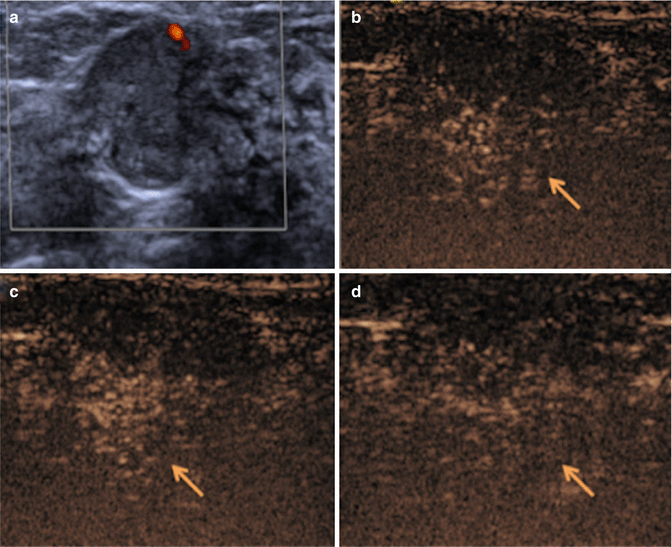
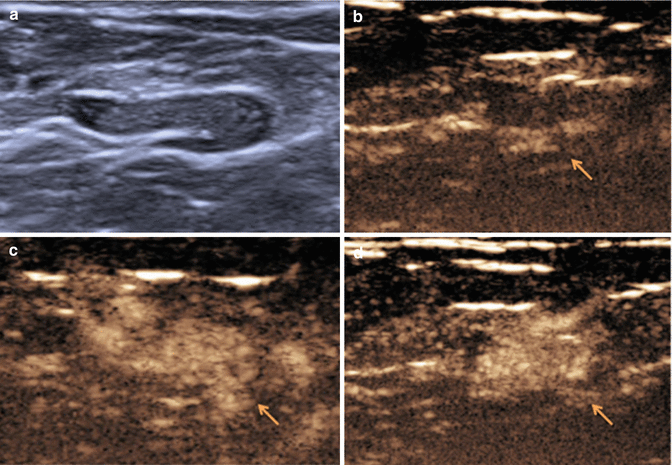

Fig. 17.17
Invasive ductal carcinoma G3 in a 46-year-old women at 6/7 o’clock of the right breast. (a) Color Doppler US of a 3 cm round-shaped lesion with indistinct margins demonstrates minimal internal vascularity. (b–d, lesion marked with arrow) Contrast enhancement ultrasound (CEUS) at 20 (b), 40 (c), and 65 (d) seconds demonstrates rapid wash-in and washout, kinetic characteristics likely malignant. The lesion was correctly classified as BI-RADS 5 (highly suggestive of malignancy)

Fig. 17.18
Benign breast tumor (papilloma) in a 36-year-old woman at 6 O’clock of the left breast. (a) B-mode US shows a 1 cm intraductal lesion. (b–d, arrow in b–d) Contrast enhancement ultrasound (CEUS) at 20 (b), 40 (c), and 65 (d) seconds demonstrates rapid wash-in and an homogenous plateau enhancement (indeterminate). The lesion was correctly classified as BI-RADS 4a (low suspicious of malignancy)
Tumor Characterization and Prognosis
Benign and malignant breast lesions behave differently with regard to the degree and kinetics of Doppler US contrast enhancement [263]. A high maximum intensity of ultrasound signal during bolus transit [276] and a high regional blood flow have been described as being characteristic of carcinomas, with a PPV of 91 % [277]. Molecular US imaging has the potential to be used as a tool to better characterized malignant lesions. Current investigations have also shown the advantages of using targeted microbubble strategies through enhanced visualization and assessment of tumor vascularity compared to traditional contrast-enhanced US [236, 237, 278]. Bachawal et al. [279] tested the sensitivity and specificity of BR55 to differentiate benign from malignant entities in the breast in a transgenic mouse model. The authors found a sensitivity of 84 % and a specificity of 89 %. This new approach seems to be a promising tool for early breast cancer detection. Thus, molecular US can serve as additional screening strategy, especially in women with dense breasts [280].
Therapy Monitoring
Differences in the morphology and location of blood vessels inside and in the periphery of benign and malignant tumors have also been observed, but with some variation of results partially due to differences in the contrast agents and dosages used [268, 269, 276, 281]. CEUS has shown promising results in several xenograft model studies [282, 283]; however, to date, there are no published data about CEUS for the evaluation of tumor response to neoadjuvant chemotherapy. Recently, multitargeted microbubbles have also shown the potential to evaluate the early tumor response to antiangiogenic therapy [271], enabling a noninvasive approach to determine the early tumor response to antiangiogenic therapy through molecular US imaging.
17.3.3.2 Ultrahigh-Field MRI of Breast Tumors
Recently, ultrahigh-field MR scanners, operating at a field strength of 7 T, have become clinically available. Compared to MRI at 3 T, ultrahigh-field MRI at 7 T provides a significantly increased intrinsic SNR [101] that can be translated either into even higher temporal and spatial resolution [100, 284] or into functional and metabolic imaging [100, 285]. Initial studies investigating unilateral DCE-MRI of the breast at 7 T have demonstrated the feasibility and encouraged the implementation of further advanced bilateral coil concepts to fully explore the diagnostic potential of DCE-MRI at 7 T [286–288]. In the first clinical study, Pinker et al. investigated the application of bilateral high-resolution DCE-MRI at 7 T in patients with breast lesions [95, 289, 290]. In that study, high-resolution DCE-MRI of the breast at 7 T had a sensitivity of 100 % and a specificity of 90 %, resulting in a diagnostic accuracy of 96.6 % with an AUC of 0.95 (Figs. 17.19 and 17.20). Overall image quality was excellent in the majority of cases and examinations were not hampered by artifacts. The authors concluded that bilateral high-resolution DCE-MRI of the breast at 7 T is clinically applicable and enables a breast cancer diagnosis with a high diagnostic accuracy and excellent inter-rater agreement and image quality. As the increase in intrinsic SNR can also be exploited for functional imaging, several studies have investigated the application of DWI in breast cancer diagnosis at 7 T [101, 291]. DWI at 7 T yields high-quality ADC maps and high-spatial-resolution T2-weighted MR images that can be used to assess tumor and breast morphology, and ADC quantification enables an excellent differentiation of benign and malignant breast lesions. Recently, the concept of multiparametric MRI has been extended to 7 T. Pinker et al. evaluated whether multiparametric MRI of the breast, combining high-resolution DCE-MRI and DWI at 7 T, is feasible and could improve diagnostic accuracy [102]. Multiparametric MRI, combining high-resolution DCE-MRI and DWI at 7 T, yielded a sensitivity of 100 %, a specificity of 88.2 %, and an AUC of 0.941, which was significantly greater than DCE-MRI (p = 0.003) with a sensitivity of 100 %, a specificity of 53.2 %, and an AUC of 0.765 and DWI, with a sensitivity of 93.1 %, a specificity of 88.2 %, and an AUC 0.907 (Fig. 17.21). In that study, multiparametric MRI of the breast at 7 T accurately detected all cancers, reduced false positives from eight with DCE-MRI to two (Fig. 17.22), and, thus, could have obviated unnecessary breast biopsies (p = 0.031). Therefore, multiparametric MRI of the breast with DCE-MRI and DWI at 7 T is feasible in clinical practice and seems to enable breast cancer diagnosis with a high diagnostic accuracy and excellent inter-rater agreement. In a quite recent study, Schmitz et al. investigated multiparametric MRI with three parameters, i.e., DCE-MRI, DWI, and 31-phosphorus spectroscopy (31P MRSI) at 7 T for the characterization of breast cancer [161]. The authors concluded that multiparametric 7 T breast MRI with three parameters is feasible in the clinical setting and showed an association between ADC and tumor grade and between 31P MRSI and mitotic count.
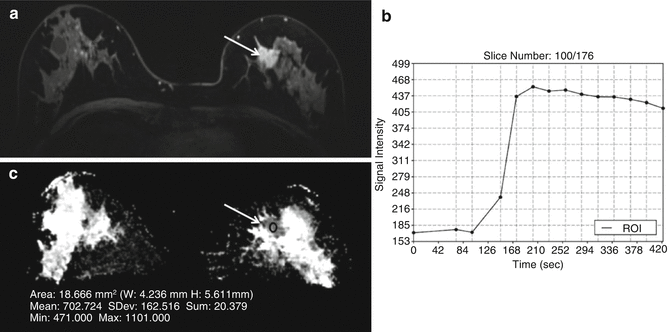
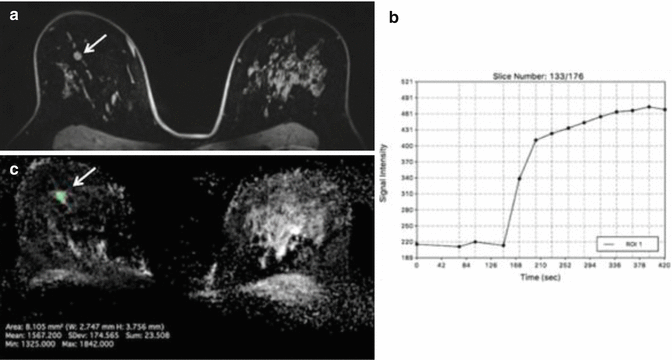
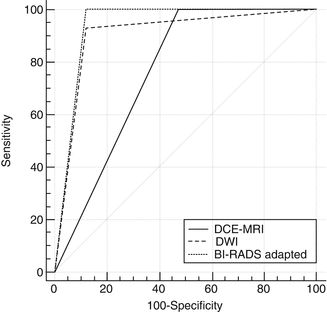
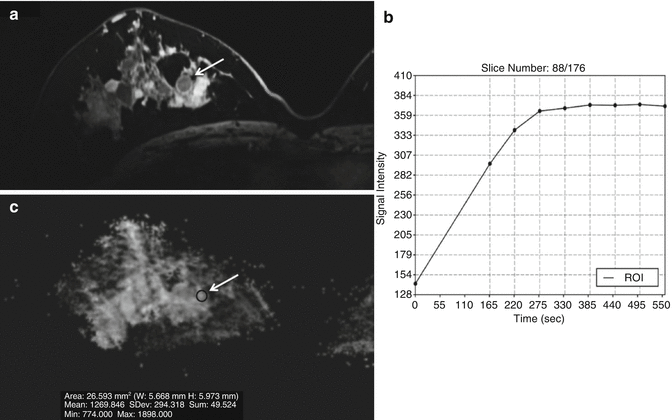

Fig. 17.19
Multiparametric MRI at 7 T with DCE- MRI and DWI. Invasive ductal carcinoma G2 in a 68-year-old woman at 11 o’clock in the left breast. (a) The irregular-shaped mass with spiculated margins (arrow) demonstrates (b) heterogeneous initial strong enhancement followed by a washout. (c) On diffusion-weighted imaging (DWI), the ADC values (0.702 × 10−3 mm2/s) were below threshold for malignancy (arrow) and were accurately classified as BI-RADS 5 (highly suggestive of malignancy)

Fig. 17.20
Multiparametric MRI at 7 T with DCE- MRI and DWI. Fibroadenoma in a 50-year-old woman at 2 o’clock in the right breast. (a) The round and circum- scribed mass (arrow) demonstrated (b) an initial moderate/persis- tent (II) homogenous contrast enhancement. (c) On diffusion-weighted imaging (DWI), the ADC values (1.567 × 10−3 mm2/s) were well above threshold for malignancy (arrow) allowing an accurate classification as a benign finding with the BI-RADS-adapted reading

Fig. 17.21
Receiver operator characteristic curves illustrate the higher diagnostic value of multiparametric MR imaging compared with DCE imaging and DWI of the breast (Reproduced from Pinker et al. [102])

Fig. 17.22
Multiparametric MRI at 7 T with DCE-MRI and DWI. Fibroadenomatous hyperplasia in a 39-year-old woman at 3 o’clock in the right breast adjacent to a cyst (arrow). (a) The irregularly shaped and partly irregularly marginated mass lesion demonstrates (b) homogenous initial strong enhancement followed by a plateau is classified by DCE-MRI of the breast as BI-RADS 4 (probably malignant). (c) However, the ADC values are not below the cutoff for malignancy (1.269 × 10−3 mm2/s) allowing an accurate classification as a benign finding with the BI-RADS-adapted reading
Emerging Parameters for Ultrahigh-Field MRI
Sodium MR Imaging (23NA MRI)
Sodium (23Na) MR imaging has emerged as novel functional MRI parameter for the tumor characterization and therapy monitoring of breast cancer. 23Na MRI provides information about the physiological and biochemical state of tissue, and the sodium concentration is a sensitive indicator of cellular and metabolic integrity, as well as ion homeostasis [292, 293]. In healthy cells, a low intracellular sodium concentration is maintained by the Na+/K+ ATPase pump actively pumping sodium out of the cell against a concentration gradient formed by the much higher extracellular sodium concentration. 23Na MRI detects increased sodium levels that occur when there is a failure of the Na+/K+-ATPase pump secondary to the breakdown of cell membranes, as seen in malignancy. Ouwerkerk et al. investigated the potential of 23Na MRI for the differentiation of benign and malignant breast lesions at 1.5 Tesla [294]. Those authors demonstrated that an increased total sodium concentration in breast tumors appears to be a sensitive cellular-level indicator of malignancy and has the potential to increase the specificity of breast MRI. At field strengths of 1.5 and 3 T, 23Na MRI is limited. Recently, 23Na MRI has been established at 7 T with promising results. Zaric et al. investigated quantitative 23Na MRI at 7 T and compared it to DWI at 7 T. That study demontrated that quantitative 23Na MRI at 7 T could be accomplished with good resolution and image quality, within clinically acceptable measurement times in patients with breast tumors. 23Na MRI allowed good discrimination of benign and malignant breast lesions (p = 0.002) (Figs. 17.23 and 17.24) that was similar to that based on DW-MRI (p = 0.002). 23Na MRI can reliably provide additional information about pathophysiologic changes in tumor tissue, with the potential to improve the detection, characterization, and treatment monitoring of breast lesions [295].
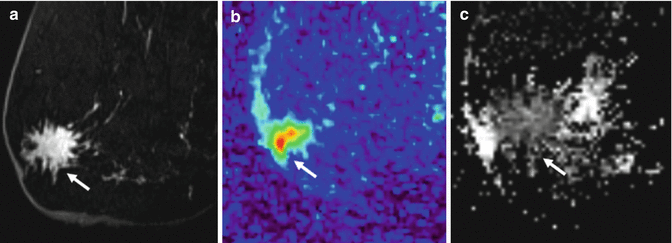
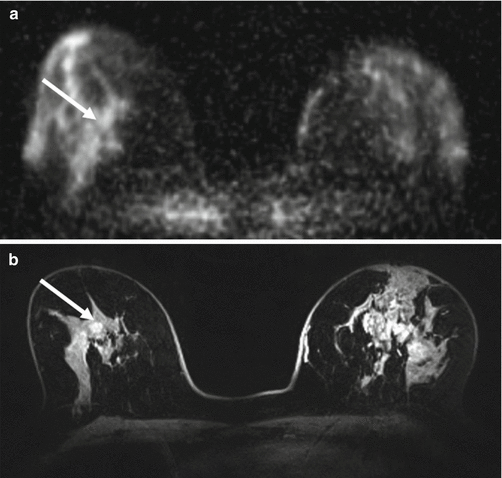

Fig. 17.23
Invasive ductal carcinoma G3 in the left breast of a 49-year-old female patient. (a) On DCE MRI there is a strongly enhancing irregular tumor (arrow) with spiculated margins. (b) Sodium (23Na) MRI reveals an increase in sodium content as result of altered metabolism in the tumor tissue. (c) Diffusion-weighted image (DWI) shows low apparent diffusion coefficient (ADC) values indicating high cellularity and tumor malignancy.

Fig. 17.24
Fibroadenoma in the right breast of a 57-year- old patient. (a) In Sodium (23Na) MR the tumor (arrow) shows slightly increase in signal compared to glandular tissue; 1.5 in- plane resolution image enables good delineation between morphologic structures (glandular and adipose tissue). (b) On DCE the tumor (arrow) shows a strong enhancement but regular margins.
Phosphorus Spectroscopy (31P MRSI)
Phosphorus spectroscopy (31P MRSI) measures tissue bioenergetics and membrane phospholipid metabolism. The signals of precursors and catabolites of phospholipids can serve as an imaging biomarker for tumor characterization, prognosis, and treatment moitoring [199, 296]. Several in vitro and in vivo 31P MRSI studies have proven that elevated levels of phosphocholine (PC)/phosphoethanolamine (PE) can be detected in several cancers inclduing breast cancers. Barzilai et al. demonstrated a significant decrease in the PE/PC ratio in malignant, breast tumors compared to benign lesions [297], and changes in PE/PC ratios are observed in response to therapy. However, at field strengths of 1.5 and 3 T, the application of 31P MRSI is limited to relatively large and superficial tumors [296]. Recently, the feasibility of 31P MRSI at 7 T has been investigated, with promising results. Quantitative 31P MRSI of breast tumors at 7 T is feasible, with excellent quality of 31P-MR spectra, and can be used for clinical research. Quantitative 31P MRSI enables a specific analysis of the biochemical status of breast tissue and, thus, can be expected to serve as a valuable imaging biomarker for breast cancer diagnosis and treatment monitoring [285, 298].
Chemical Exchange Saturation Transfer (CEST) Imaging
Chemical exchange saturation transfer (CEST) is an MRI parameter that enables visualization of chemical exchange processes between protons bound to solutes and surrounding bulk water molecules [299, 300]. It has been demonstrated that the endogenous CEST can discriminate tumor from healthy breast tissue based on the information about protons associated with mobile proteins through the amide proton transfer (APT) effect and also has been implicated as a prognosticator of response to therapy [299]. Recently, Schmitt et al. investigated ATP CEST-MRI at 3 T for the detection of breast cancer, with promising results.
In that study, the detection of lesions was equally possible with DCE-MRI and ATP CEST-MRI. The results of this initial feasibility study indicate a significant potential for ATP CEST-MRI to discriminate cancer from fibroglandular tissue in the human breast through the CEST contrast generated by endogenous solute molecules.
Recently, animal studies have investigated CEST contrasts other than ATP, exploiting the entire CEST spectrum. Desmond et al. found that imaging of the amide, amine, and aliphatic signal (aaaCEST) allows a noninvasive differentiation of areas of apoptosis and/or necrosis from actively progressing tumor [301]. In addition, similar to [18F]fluorodeoxyglucose positron emission tomography ([18F]FDG), dynamic CEST after the administration of glucose (glucoCEST) has been shown to enable the noninvasive evaluation of the kinetics of glycolysis, which are typically increased in malignant lesions [19]. Initial results indicate that glucoCEST potentially might serve as a substitute for PET/CT or PET/MRI in the clinic for the detection of tumors and metastases, distinguishing between malignant and benign tumors and monitoring tumor response to therapy, without the need for radiolabeled isotopes [302–305].
Nevertheless, further studies will be necessary to explore the true potential of CEST imaging in breast cancer.
Hyperpolarized Magnetic Resonance Spectroscopic Imaging (HP MRSI)
Hyperpolarized magnetic resonance spectroscopic imaging (HP MRSI) is one of the most recent advances in molecular imaging. HP MRSI allows a rapid, radiation-free, noninvasive investigation of tumor metabolism by exploiting exogenous contrast agents that have been “hyperpolarized.” Conventional MR imaging depends on nuclear spins that have been polarized on the order of a few parts per million, whereas, in HP MRSI, nuclear spins reach near-unity polarization, resulting in an extensive increase in signal intensity [306, 307]. With HP MRSI, nuclear spins are polarized in an amorphous solid state at ~1.2 K through coupling of the nuclear spins with unpaired electrons that are added to the sample via an organic free radical. In the solid state, the high electron spin polarization is, in part, transferred to the nuclear spins by microwave irradiation, and then the sample is rapidly dissolved for injection into the system of interest. Recently, 13C-labeled substrates have been polarized to obtain dramatic enhancements of the 13C nuclear MR signals (>50,000 fold at 3 T) of the substrate, as well as subsequent metabolic products [308]. The enhancement that is achieved is lost in time as a function of the spin–lattice relaxation time of the nucleus (T1). The HP 13C probes can be injected into living systems and their metabolism observed in real time by chemical shift. (13C) pyruvate has been the most widely used probe for HP MR studies since it polarizes well, has a long T1, and is rapidly taken up by the cell and metabolized at the juncture of glycolysis, TCA, amino acid biosynthesis, and other critical pathways. Several animal studies have confirmed real-time measurement of the relative transformation of pyruvate into lactate and alanine using HP MRSI, which allows differentiation of tumor from normal tissue [309–311]. In addition to the differentiation between malignant and nonmalignant cells [310, 312, 313], HP MRSI using 13C pyruvate has been used for the assessment of cancer progression [314, 315]. Recently, other novel probes for redox (13C dehydroascorbate), necrosis (13C fumarate), and glutamine metabolism (13C glutamine) have been developed to interrogate other metabolic pathways and have shown promising results [316]. To our knowledge, to date, there has been no specific clinical application of HP MRSI to breast cancer; however, several preclinical and initial studies in cancer, including breast cancer [317], suggest that this technique may be applicable for the detection of breast cancer and for the assessment of treatment response in the future.
Stay updated, free articles. Join our Telegram channel

Full access? Get Clinical Tree




